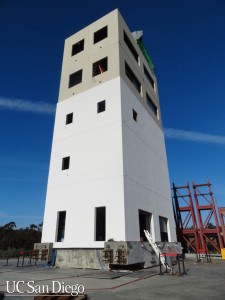What happens when a series of massive earthquakes hits a five-story medical facility with an intensive care unit, operating room and elevator?

Structural engineers at the University of California, San Diego, hope to find out by repeatedly shaking such a building over the next two weeks as part of a $5 million experiment funded by government agencies, foundations and others. The experiment starts Tuesday.
The project reflects a new way of thinking among earthquake safety experts who have been focusing on shoring up hospitals, large apartment buildings and schools so that communities can rebound quickly after a disaster.
Since the 1989 Loma Prieta earthquake in the San Francisco Bay Area and the 1994 Northridge temblor near Los Angeles, billions of dollars have been spent on retrofitting thousands of unreinforced brick buildings, roads, bridges and university buildings. Yet thousands of potentially dangerous concrete school buildings, high-rise apartments and hospitals that were built before California changed its building code in 1976 haven’t been identified, according to experts.
“What we are doing is the equivalent of giving a building an EKG to see how it performs after an earthquake and a post-earthquake fire,” said Tara Hutchinson of the Jacobs School of Engineering at UC San Diego, the project’s lead principal investigator.
The project stands out because it will test what happens to items inside a building – such as elevators, stairs and medical equipment – rather than the building itself.
The project’s 80-foot structure was built atop a giant table that will shake in ways similar to recent major quakes, such as the Northridge quake and Chile’s magnitude-8.8 temblor, which struck in 2010.
The top two floors are outfitted with a surgery room and intensive care unit. More than 500 sensors and 80 cameras will be placed strategically throughout the building to monitor everything from the deformation of the rebar buried in its concrete foundations to the vibrating hospital beds and swaying surgical lights.
There are modern ceiling systems, a heating and air conditioning system, functional sprinklers, computer servers, large and small laboratory equipment and electrical equipment and wiring.
Researchers also will look at fire barriers and will run controlled burning tests following the two-week experiment to help understand how flames and smoke might spread in such a building.
Researchers expect to publish their findings after spending the next year analyzing the data.
Was this article valuable?
Here are more articles you may enjoy.

 EVs Head for Junkyard as Mechanic Shortage Inflates Repair Costs
EVs Head for Junkyard as Mechanic Shortage Inflates Repair Costs  Supplemental Claims Don’t Need to Include Damage Estimates, Fed Appeals Court Says
Supplemental Claims Don’t Need to Include Damage Estimates, Fed Appeals Court Says  Johnson Controls Unit to Pay $750M to Settle ‘Forever Chemicals’ Lawsuit
Johnson Controls Unit to Pay $750M to Settle ‘Forever Chemicals’ Lawsuit  Oregon Schools Sued for $9M After Young Girl Allegedly Raped
Oregon Schools Sued for $9M After Young Girl Allegedly Raped 